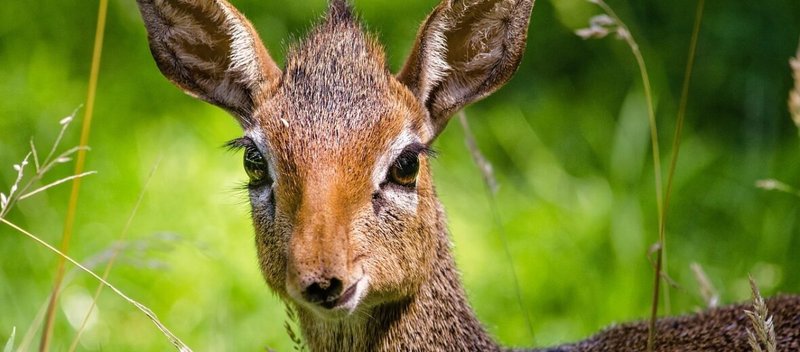
Dik-diks belong to the Bovidae family and can be found in various parts of East and Southern Africa. While they are equally fascinating and vulnerable, their conservation status varies across species. So, let’s dive into what it means for these little guys to be endangered, why that matters, and what’s being done to protect them.
What Are Dik-Diks?
Let me give you the rundown on dik-diks. They’re small antelopes, standing only about 12 to 16 inches tall at the shoulder. Imagine holding a small dog—this gives you a sense of their size! There are several species of dik-diks, including the Kirk’s dik-dik, the Guenther’s dik-dik, and the Salt’s dik-dik. Each has unique characteristics, but they all share similar features, like their long snouts and large, expressive eyes.
Dik-diks get their name from the sound they make when they’re startled—a little “dik-dik.” They thrive in grasslands, bushlands, and scrubby areas where they can find plenty of shrubs to munch on. These animals are primarily browsers, meaning they eat leaves and shoots. Their dietary habits make them important players in their habitats, as they help disperse seeds and manage plant growth.
Are Dik-Diks Endangered?
To answer the burning question: Yes, some species of dik-diks are considered endangered or vulnerable. For instance, the Guenther’s dik-dik is classified as Near Threatened by the IUCN Red List. This status means it’s not immediately at risk of extinction, but it’s on a shaky path that could lead to endangerment if protective measures aren’t taken.
You might be wondering what causes these cute creatures to be classified as endangered. The main culprits are habitat loss and poaching. As human populations expand, dik-dik habitats are often converted for agricultural use or urban development. Imagine waking up one day to find your home replaced by a bustling city—this is what dik-diks are facing.
Why Are Dik-Diks Important to Their Ecosystem?
Dik-diks play a vital role in their ecosystem, acting as both prey and seed dispersers. They contribute to the grazing balance in their habitat. When they feed on shrubs, they help control plant overgrowth, allowing various plant species to thrive.
Their presence also supports the food web. Predators like birds of prey and carnivorous mammals rely on these little antelopes for sustenance. If dik-diks were to disappear, it would create a ripple effect, disrupting the balance of their ecosystem.
Let’s not forget their role in seed dispersal. When dik-diks eat fruits and vegetables, they also help propagate those plants by spreading seeds through their droppings. This not only supports plant diversity but also helps maintain the overall health of their habitats.
Threats Faced by Dik-Diks
The threats to dik-diks primarily stem from human activities. Here are a few of the biggest challenges they face:
- Habitat Loss: As mentioned earlier, urban expansion and agricultural developments are significant issues. When forests and grasslands are cleared, dik-diks lose their homes, food sources, and safe places to hide from predators.
- Poaching: These adorable antelopes are sometimes hunted for their meat and skins. Unfortunately, illegal hunting contributes to their declining numbers.
- Climate Change: Changes in climate can alter their habitats, leading to less available food and water. Extreme weather events can also threaten their survival.
It’s a tough world out there for dik-diks, and understanding these threats is the first step towards helping them.
Conservation Efforts for Dik-Diks
So, what’s being done to protect these tiny antelopes? Thankfully, various conservation efforts are underway. Here are a few key strategies:
- Protected Areas: Establishing national parks and reserves helps safeguard dik-dik habitats. These protected areas allow dik-diks to thrive without the imminent threat of habitat destruction.
- Community Involvement: Engaging local communities in conservation efforts is crucial. When people understand the importance of dik-diks and their role in the ecosystem, they are more likely to support protective measures.
- Research and Monitoring: Ongoing research helps conservationists understand dik-dik populations and their needs. Monitoring their habitats ensures that conservation strategies are effective.
These efforts show promise, but they require continued support and attention to ensure dik-diks don’t fade into the fabric of history.
What Can You Do to Help?
You might feel far removed from the plight of dik-diks, but there are ways you can lend a hand. Here’s how:
- Educate Yourself and Others: The more you know about dik-diks and their ecosystems, the better equipped you are to advocate for them. Share what you learn with friends and family!
- Support Conservation Organizations: Look for NGOs working to protect wildlife in Africa. Your donations can help fund projects aimed at conserving dik-dik habitats.
- Reduce Your Carbon Footprint: Engaging in sustainable living practices can indirectly help conserve habitats. Every little bit counts in the fight against climate change.
Remember, every action you take contributes to the greater good of the planet, including our little friends like the dik-dik.
In a world that often seems indifferent to wildlife, the plight of the dik-dik serves as a reminder of our responsibility to protect all creatures, big and small. These delicate antelopes are not just a testament to the beauty of nature; they also play a critical role in maintaining the balance of their ecosystems.
As we learn more about the threats they face and the efforts underway to protect them, it’s easier to see how interconnected we all are. By making informed choices and supporting conservation efforts, we can help ensure that future generations will also marvel at the wonder of the dik-dik. Let’s rally together for these incredible creatures and their habitats—after all, every little bit helps!
